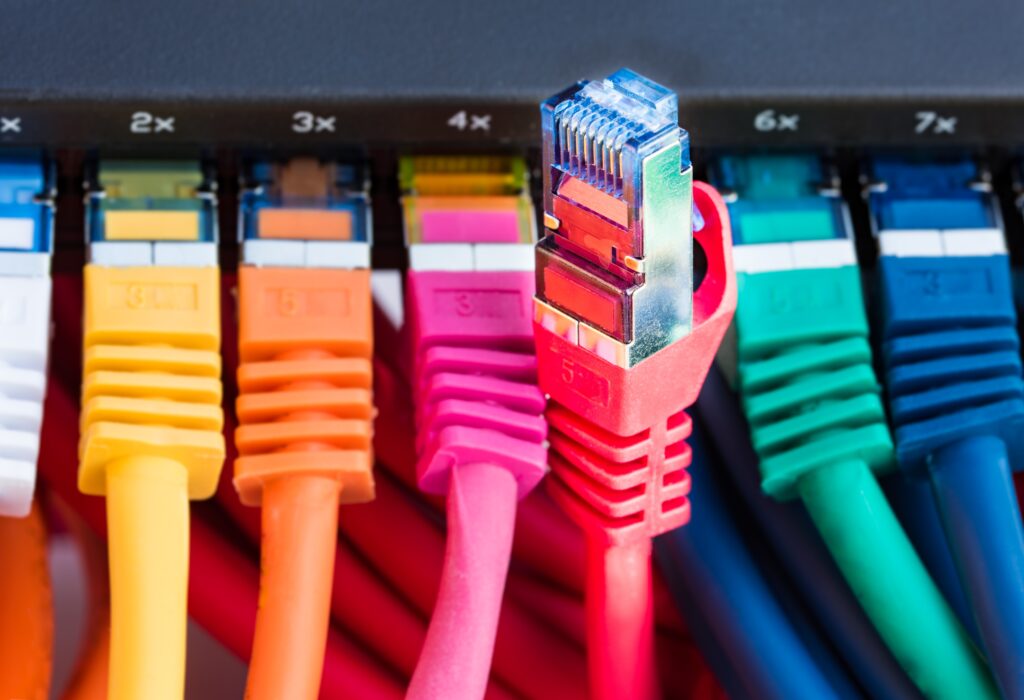
Apr 20 2024
/
23AWG vs 24AWG Cat6 Cables: Which is Best for Your Network Setup?
In the complex world of network cabling, choosing between 23AWG and 24AWG Cat6 cables is key, especially for IT professionals or small businesses handling network setups. These cables might look similar, but their subtle differences can greatly affect network performance and installation costs. Let’s dive deeper into a comparison to find out which cable might be the best choice for your network.
Understanding Cat6 Cables
Category 6 (Cat6) cables, defined by the EIA and TIA, support higher bandwidth and faster network speeds than earlier versions like Cat5 and Cat5e cables.
The key characteristics of Cat6 cables include:
- Support for Gigabit Ethernet, where data can transfer at speeds of up to 1 Gigabit per second (Gbps).
- Backward compatibility with Cat5 and Cat5e, making it a cost-effective upgrade from existing infrastructures.
- A variety of twisted-pair configurations, each with distinct advantages.
The Wire Gauge Dilemma: 23AWG vs. 24AWG
The American Wire Gauge (AWG) system dictates the diameter of the wire used in the cable. In the context of Cat6 cables, you will commonly encounter two main categories:
23AWG Cat6 Cables
23AWG cables, with their larger-diameter copper conductor, have lower electrical resistance, resulting in less heat and potentially improved transmission over longer distances. They can handle high power and deliver a clearer signal, making them ideal for Power over Ethernet (PoE) applications where the cable powers connected devices.
24AWG Cat6 Cables
24AWG cables have a smaller conductor but still meet Cat6 standards. They’re more flexible and easier to install in tight spaces due to their thinner construction. They also tend to be cheaper than 23AWG cables because they use less copper.
Performance Factors to Consider
While both types of cables adhere to Cat6 standards, their performance in real-world applications can diverge. Here are the key points to consider:
Signal Degradation and Crosstalk
Crosstalk is the undesirable transfer of signals between communication channels and can significantly reduce the quality of data transmissions. Cables with larger AWG numbers may exhibit more crosstalk due to their smaller size, but this factor can also be influenced by the cable’s manufacturing quality.
Distance and Attenuation
Attenuation is the weakening of a signal over a length of cable. 23AWG cables typically show lower attenuation compared to 24AWG cables, allowing for longer transmission distances without a significant loss in signal strength.
PoE Applications
23AWG cables can handle more power with minimal voltage drops, essential for PoE applications where consistent power is crucial. This is increasingly important in everything from small office/home office (SOHO) setups to enterprise environments.
Cost and Installation
The decision between 23AWG and 24AWG Cat6 cables may also come down to budget and installation requirements:
Initial Cost
24AWG cables, with their reduced copper content and smaller size, are generally less expensive than their 23AWG counterparts. For larger installations, this cost difference can amount to significant savings.
Long-Term Performance and Maintenance
Though initially costlier, 23AWG cables can provide better long-term performance and a stronger network infrastructure. Selecting the right cable can lower maintenance expenses and lessen problems like signal degradation over time.
Environmental and Application Constraints
If you’re in a tight space or need cables that frequently flex, the pliable 24AWG cable could suit you better. But for typical office or data center settings, consider the performance benefits of 23AWG cable.
Case Studies and Practical Applications
To further illustrate the above considerations, it’s helpful to look at specific scenarios:
Small Business Networks
For a small business with a limited budget and short-run network cabling, 24AWG Cat6 cables could provide a cost-efficient solution without compromising network speeds.
Data Centers and Enterprises
In contrast, the strong performance and less interference of 23AWG Cat6 cables may be better for data centers or enterprise networks, where large data transfers and minimal signal interference are crucial.
Long-Distance Installations
When installing cabling over long distances, like in warehouses or on campuses, 23AWG cables are better due to lower attenuation. This ensures signal integrity without extra costs for signal boosters or infrastructure.
The Verdict: When to Choose 23AWG or 24AWGh
In the end, the choice between 23AWG and 24AWG Cat6 cables depends on various factors like network size, budget, performance demands, and installation conditions. Here’s a summary to help guide your decision:
- Choose 23AWG for superior performance over long distances, in PoE applications, and for robust, future-proof installations.
- Opt for 24AWG when flexibility and initial cost savings are the primary considerations, especially in short-run or space-constrained setups.
Remember, quality trumps all. Regardless of wire gauge, investing in high-quality Cat6 cables from reputable manufacturers will ensure a reliable, high-performing network.
Frequently Asked Questions
Can 24AWG Cat6 cables be used for Power over Ethernet (PoE) applications?
While 24AWG Cat6 cables support PoE, 23AWG cables are preferred due to their lower resistance and better suitability for higher-power PoE devices.
How significant is the cost difference between 23AWG and 24AWG Cat6 cables?
The price difference varies by manufacturer and cable length. Generally, 23AWG cables are a bit more expensive because of the thicker copper wire, but they can save on maintenance and future upgrades.
Will using 23AWG cables guarantee a faster network?
Not always. Although 23AWG cables have lower attenuation and could provide higher speeds over long distances, actual speed depends on network hardware, design, and application use.
Are there any drawbacks to using 23AWG cables in a small business network?
The main downside is the higher cost of 23AWG cables. They are also thicker and less flexible, which may affect installations with limited space.
Can I mix 23AWG and 24AWG cables in the same network?
Mixing 23AWG and 24AWG Cat6 cables in a network is possible, but it’s important to consider each cable type’s limitations. For best performance, ensure the cables meet the specific needs of your network.
